Lamp drivers enable future residential LED lighting
Cutting cost by reducing LED system components is key to growing the LED residential lighting segment
BY BRIAN JOHNSON
America’s and Europe Lighting Specialist
Fairchild Semiconductor
www.fairchildsemi.com
The worldwide market for light bulbs was a little over 20 billion units for the year 2010 with the LED unit count approximately 0.5% or 96 million units (see Fig. 1 ). The LED unit count includes all types of LED units ranging from automotive, traffic lights, signage, to specialty and camera flash. Residential high-brightness LEDs consisting of MR16, PAR, A19, E14/17, and E26/27 bulb types accounted for 800,000 units in 2010 (see Fig. 2 ). [1]
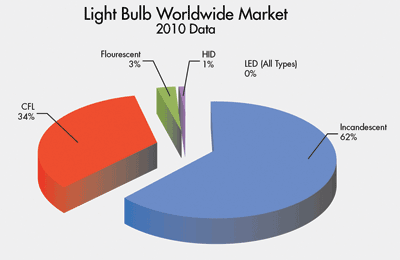
Fig. 1: Light bulb worldwide market
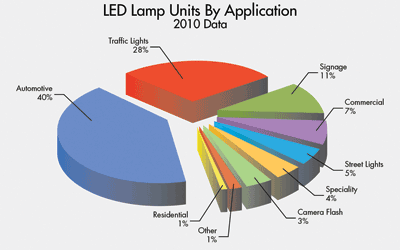
Fig. 2: LED lamp units by application [1]
The LED lamp unit projected growth is expected to double by the year 2013 with a growth of a factor of 10 by year 2016 (see Fig. 3 ). [1]

Fig. 3: LED lamp projected growth [1]
However, in order to realize these LED lamp unit growth projections, the cost of residential LEDs must decrease. It is total cost that the end user sees and becomes the most frequent barrier to the adoption of the LED light solutions regardless of the performance improvements derived from LED light solutions. The U.S. Department of Energy estimates that LED drivers make up greater than 10% for the total cost for a LED driver (see Fig. 4 ). In order to achieve the projected LED lamp growth, the cost of the LED driver will have to reduce by a factor of four (see Fig. 5 ).
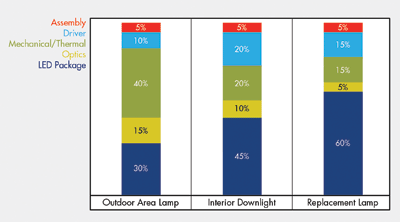
Fig. 4: Approximate cost proportions [2]
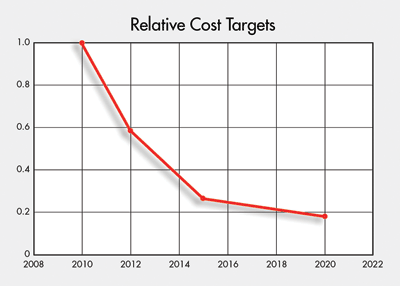
Fig. 5: Cost reduction targets [3]
Cost is not the only challenge to the LED driver designer. The designer has a small printed circuit board (PCB) size to implement design features like power factor correction (PFC), dimming, and safety requirements. The residential user requires operating life, also known as warranty periods, greater than three years, to even greater than five years. Power factor correction is needed to achieve Energy Star rating which starts with LED light applications from 5-W input and greater. [4]
As an example of the small PCB challenge, there are two types of printed circuit board form factors for a MR16 application. One shape, shown in Fig. 6 , is a round shape to adopt against the LED module back side. The round diameter should be smaller than 30 mm with taller components located within 5 mm from the center connector.
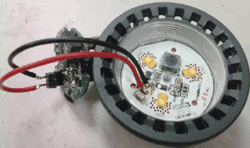
Fig. 6: MR lamp round type PCB design
The other printed circuit board form factor, shown in Fig. 7 , is a vertical type. It needs to be smaller than 30 x 20 mm.
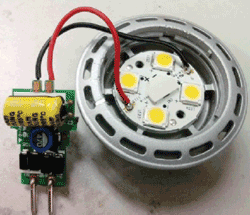
Fig. 7: MR lamp vertical type PCB design
The solution to these challenges is to use a single stage, buck, PFC driver topology. The buck topology requires no transformer or snubber circuit. The driver controller IC would have PFC part of its control strategy and the control IC can be powered from the rectified off-line input using a small ceramic capacitor for hold-up.
With an LED load that does not have tight current ripple specifications; all electrolytic capacitors can be eliminated improving the warranty period of the driver. An example is shown in Fig. 8 , the FL7701.
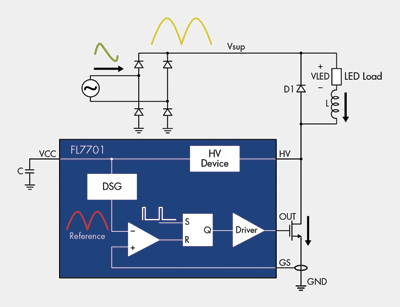
Fig. 8: FL7701 smart non-isolated PFC buck LED driver solution
This Smart Buck PFC controller is a simpler solution when compared to the popular flyback topology which requires a transformer and snubber. The flyback topology may require a passive PFC circuit. The Smart Buck PFC solution is also a simpler solution when compared to a two stage approach of having a PFC first stage followed by a second dc/dc stage which at times is the buck topology.
Analog dimming is an improvement over Triac dimming since the energy lost due to holding currents with the Triac design are not required. Analog dimming is easier to implement with residential lighting applications since the dimming mechanism can be placed closer to the light source, for example in a desktop lamp or over the counter lighting system, the dimming and switch are housed in the light fixture base or extension.
The Smart Buck PFC solution integrates functions enabling a LED driver to meet worldwide safety and regulatory requirements while reducing component counts, especially electrolytic capacitors, for improved warranty periods. Reducing components by leveraging function integration into the controller is the trend needed to realize reduced cost projections to grow the LED residential lighting segment by a factor of 10 in 2016. ■
References
[1] Communications with Selantek, Inc.
[2] U.S. Department of Energy, SSL Research and Development Manufacturing Roadmap July 2011, http://apps1.eere.en ergy.gov/buildings/publica tions/pdfs/ssl/ssl_manuf-roadmap_july2011.pdf
[3] Fred Welsh, Cost Trends for Solid State Lighting, DOE 2011 Solid-State Lighting Market Introduction Workshop, http://apps1.eere.energy.gov/build ings/publications/pdfs/ssl/welsh_cost_sslmiw2011.pdf
[4] Energy Star Program Requirements Product Specifications for Luminaires (Light Fixtures) Version 1.0
Advertisement
Learn more about Fairchild Semiconductor





